Abstract
Carbapenems such as imipenem and meropenem are not rapidly hydrolyzed by commonly occurring beta-lactamases. Nevertheless, it was possible, by mutagenesis and selection, to isolate mutant strains of Enterobacter cloacae and Proteus rettgeri that are highly resistant to meropenem and imipenem. Two alterations were noted in the E. cloacae mutants. First, the mutant strains appeared to be strongly derepressed in the production of beta-lactamases, which reached a very high level when the strains were grown in the presence of imipenem. Second, these mutants were deficient in the production of nonspecific porins, as judged by the pattern of outer membrane proteins as well as by reconstitution assays of permeability. As with most porin-deficient mutants, their cultures were unstable, and their cultivation in the absence of carbapenems rapidly led to an overgrowth of porin-producing revertants. Analysis of the data suggests that the synergism between the lowered outer membrane permeability and the slow but significant hydrolysis of carbapenems by the overproduced enzymes can explain the resistance phenotypes quantitatively, although the possibility of alteration of the target cannot be excluded at present. With P. rettgeri mutants, there was no indication of further derepression of beta-lactamase, but the enzyme hydrolyzed imipenem much more efficiently than the E. cloacae enzyme did. In addition, the major porin was absent in one mutant strain. These results suggest that a major factor for the carbapenem resistance of these enteric bacteria is the porin deficiency, and this conclusion forms a contrast to the situation in Pseudomonas aeruginosa, in which the most prevalent class of imipenem-resistant mutants appears to lack the specific channel protein D2 yet retains the major nonspecific porin F.
Full text
PDF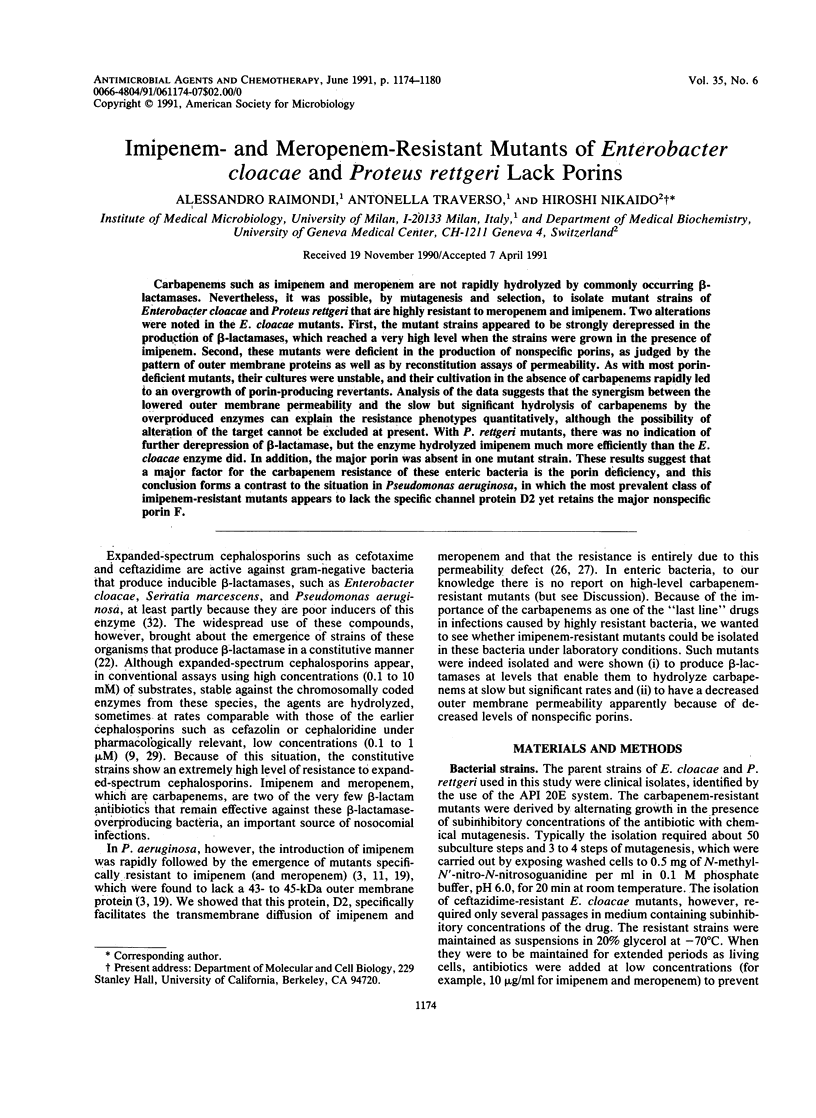
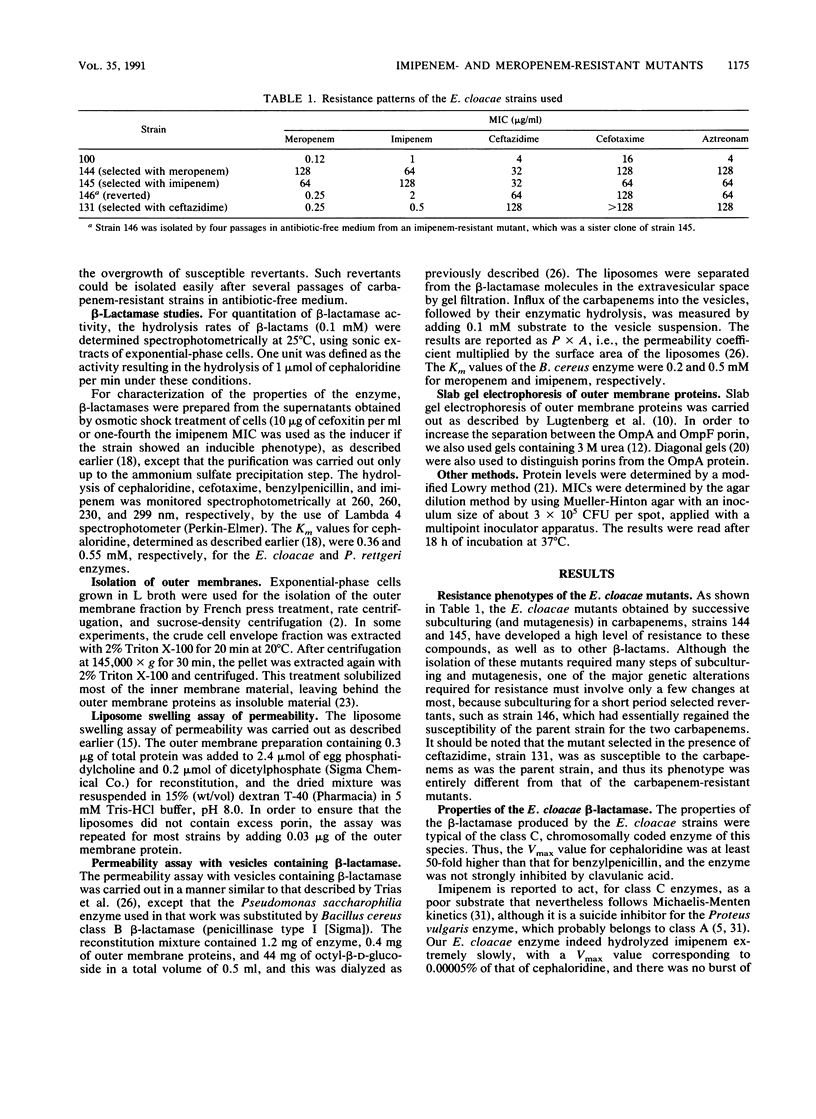
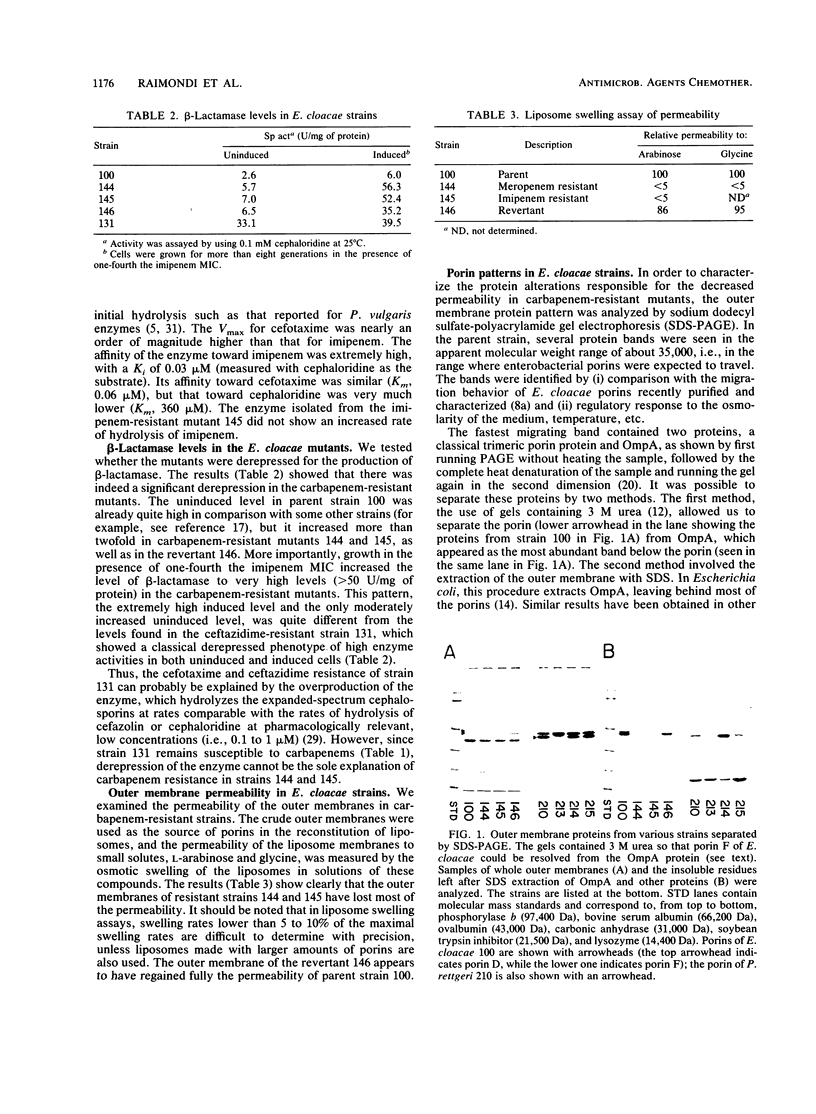
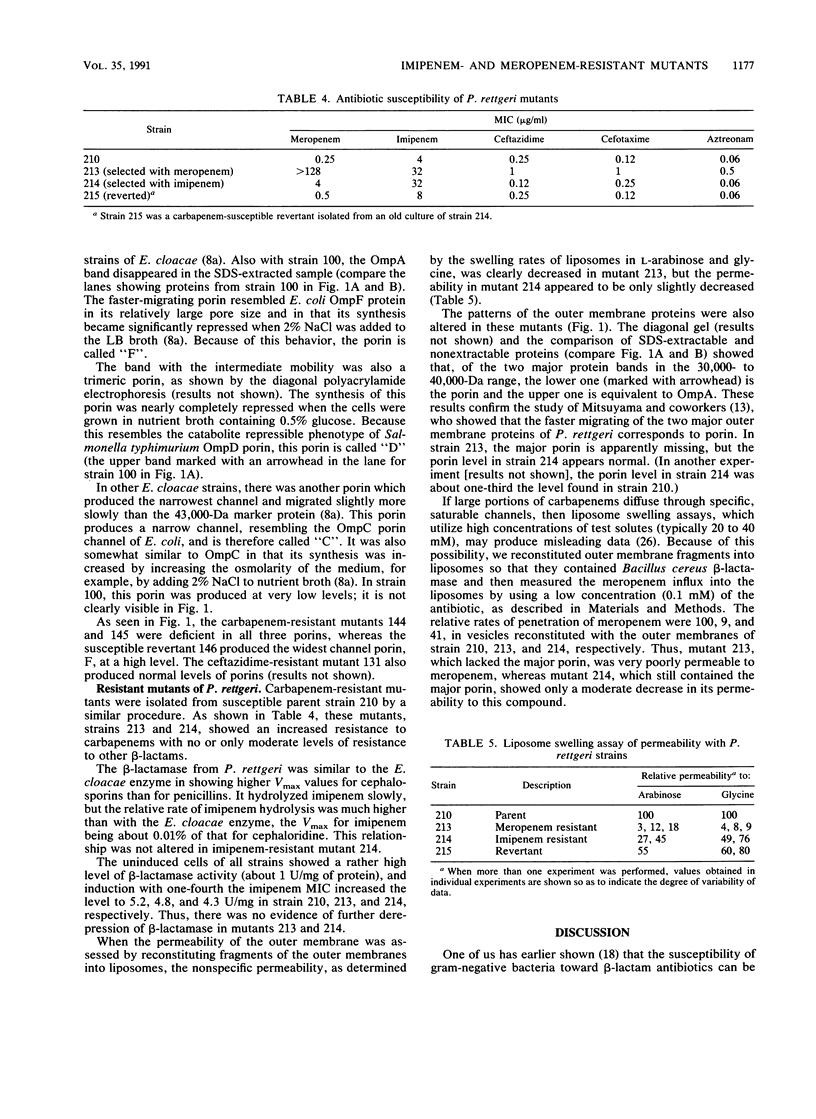
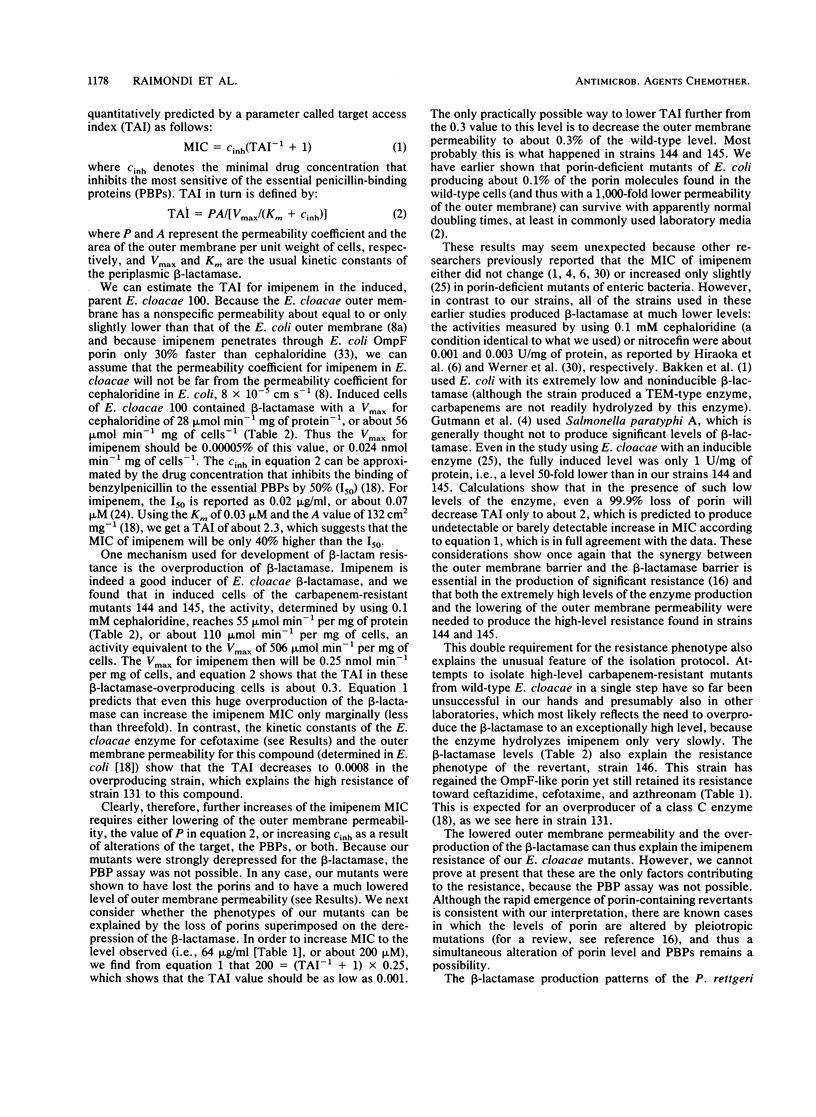
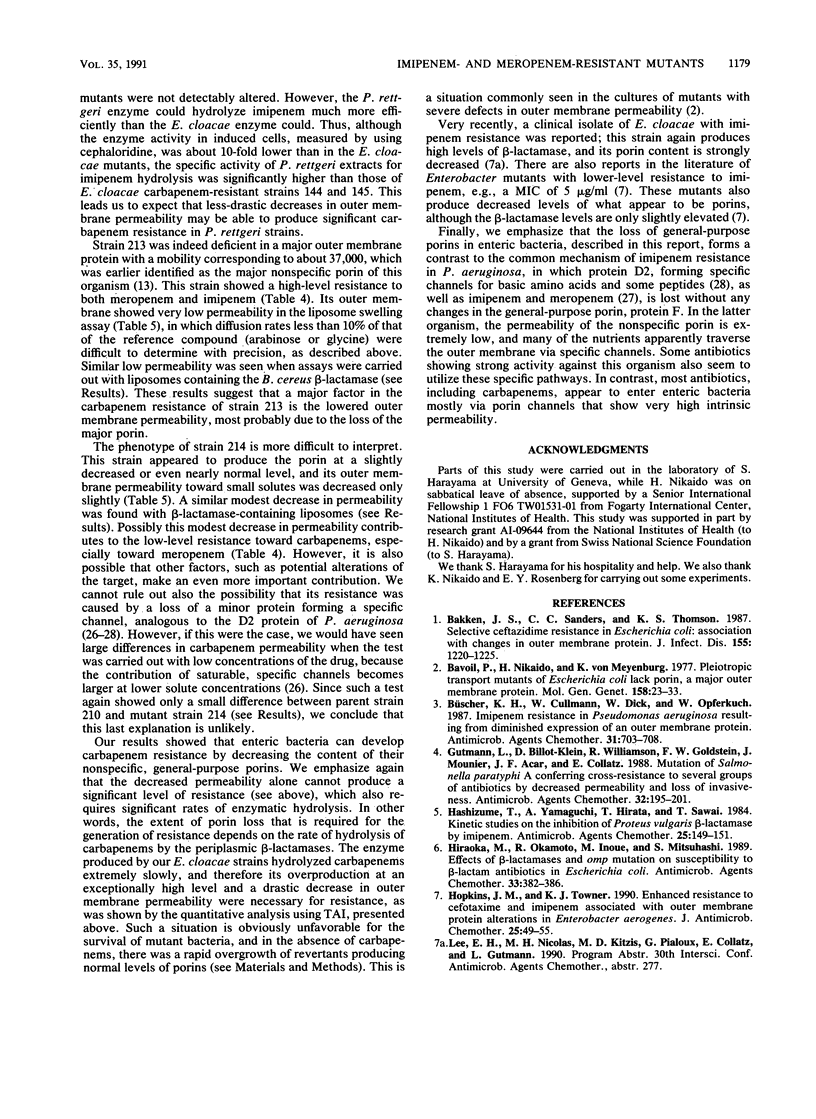
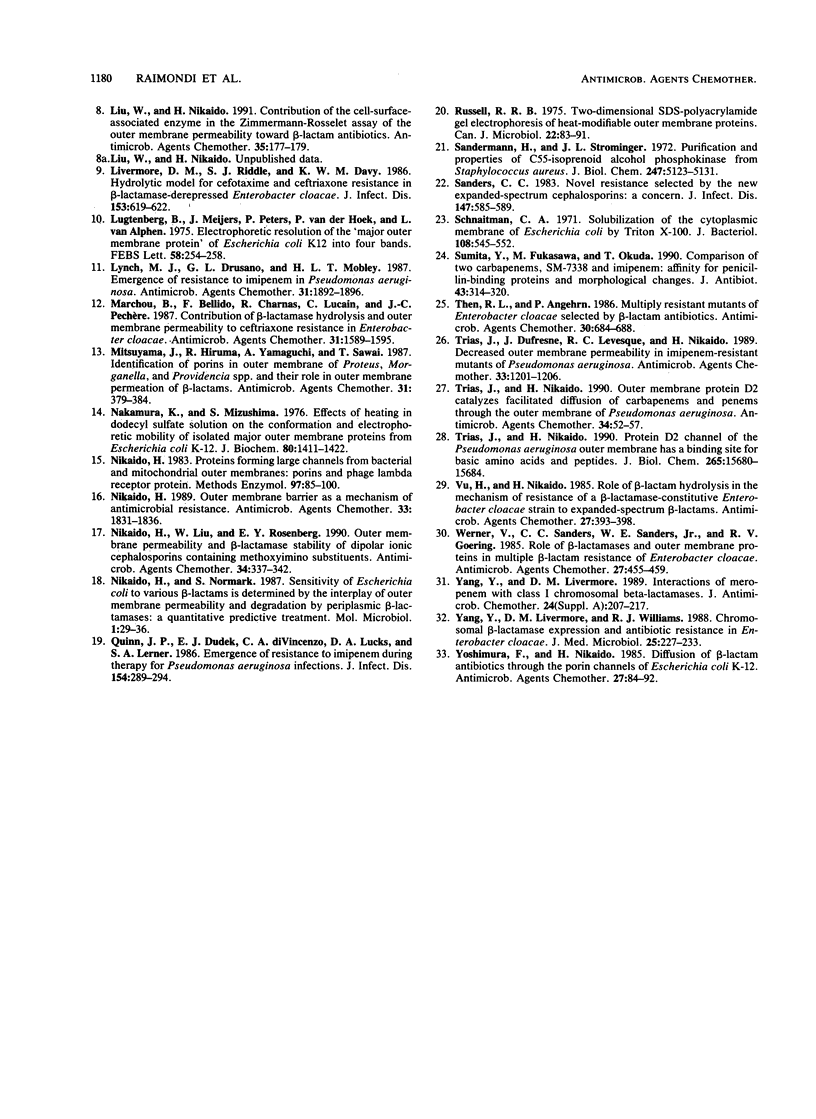
Images in this article
Selected References
These references are in PubMed. This may not be the complete list of references from this article.
- Bakken J. S., Sanders C. C., Thomson K. S. Selective ceftazidime resistance in Escherichia coli: association with changes in outer membrane protein. J Infect Dis. 1987 Jun;155(6):1220–1225. doi: 10.1093/infdis/155.6.1220. [DOI] [PubMed] [Google Scholar]
- Bavoil P., Nikaido H., von Meyenburg K. Pleiotropic transport mutants of Escherichia coli lack porin, a major outer membrane protein. Mol Gen Genet. 1977 Dec 14;158(1):23–33. doi: 10.1007/BF00455116. [DOI] [PubMed] [Google Scholar]
- Büscher K. H., Cullmann W., Dick W., Opferkuch W. Imipenem resistance in Pseudomonas aeruginosa resulting from diminished expression of an outer membrane protein. Antimicrob Agents Chemother. 1987 May;31(5):703–708. doi: 10.1128/aac.31.5.703. [DOI] [PMC free article] [PubMed] [Google Scholar]
- Gutmann L., Billot-Klein D., Williamson R., Goldstein F. W., Mounier J., Acar J. F., Collatz E. Mutation of Salmonella paratyphi A conferring cross-resistance to several groups of antibiotics by decreased permeability and loss of invasiveness. Antimicrob Agents Chemother. 1988 Feb;32(2):195–201. doi: 10.1128/aac.32.2.195. [DOI] [PMC free article] [PubMed] [Google Scholar]
- Hashizume T., Yamaguchi A., Hirata T., Sawai T. Kinetic studies on the inhibition of Proteus vulgaris beta-lactamase by imipenem. Antimicrob Agents Chemother. 1984 Jan;25(1):149–151. doi: 10.1128/aac.25.1.149. [DOI] [PMC free article] [PubMed] [Google Scholar]
- Hiraoka M., Okamoto R., Inoue M., Mitsuhashi S. Effects of beta-lactamases and omp mutation on susceptibility to beta-lactam antibiotics in Escherichia coli. Antimicrob Agents Chemother. 1989 Mar;33(3):382–386. doi: 10.1128/aac.33.3.382. [DOI] [PMC free article] [PubMed] [Google Scholar]
- Hopkins J. M., Towner K. J. Enhanced resistance to cefotaxime and imipenem associated with outer membrane protein alterations in Enterobacter aerogenes. J Antimicrob Chemother. 1990 Jan;25(1):49–55. doi: 10.1093/jac/25.1.49. [DOI] [PubMed] [Google Scholar]
- Liu W., Nikaido H. Contribution of the cell-surface-associated enzyme in the Zimmermann-Rosselet assay of outer membrane permeability of beta-lactam antibiotics. Antimicrob Agents Chemother. 1991 Jan;35(1):177–179. doi: 10.1128/aac.35.1.177. [DOI] [PMC free article] [PubMed] [Google Scholar]
- Livermore D. M., Riddle S. J., Davy K. W. Hydrolytic model for cefotaxime and ceftriaxone resistance in beta-lactamase-derepressed Enterobacter cloacae. J Infect Dis. 1986 Mar;153(3):619–622. doi: 10.1093/infdis/153.3.619. [DOI] [PubMed] [Google Scholar]
- Lugtenberg B., Meijers J., Peters R., van der Hoek P., van Alphen L. Electrophoretic resolution of the "major outer membrane protein" of Escherichia coli K12 into four bands. FEBS Lett. 1975 Oct 15;58(1):254–258. doi: 10.1016/0014-5793(75)80272-9. [DOI] [PubMed] [Google Scholar]
- Lynch M. J., Drusano G. L., Mobley H. L. Emergence of resistance to imipenem in Pseudomonas aeruginosa. Antimicrob Agents Chemother. 1987 Dec;31(12):1892–1896. doi: 10.1128/aac.31.12.1892. [DOI] [PMC free article] [PubMed] [Google Scholar]
- Marchou B., Bellido F., Charnas R., Lucain C., Pechère J. C. Contribution of beta-lactamase hydrolysis and outer membrane permeability to ceftriaxone resistance in Enterobacter cloacae. Antimicrob Agents Chemother. 1987 Oct;31(10):1589–1595. doi: 10.1128/aac.31.10.1589. [DOI] [PMC free article] [PubMed] [Google Scholar]
- Mitsuyama J., Hiruma R., Yamaguchi A., Sawai T. Identification of porins in outer membrane of Proteus, Morganella, and Providencia spp. and their role in outer membrane permeation of beta-lactams. Antimicrob Agents Chemother. 1987 Mar;31(3):379–384. doi: 10.1128/aac.31.3.379. [DOI] [PMC free article] [PubMed] [Google Scholar]
- Nakamura K., Mizushima S. Effects of heating in dodecyl sulfate solution on the conformation and electrophoretic mobility of isolated major outer membrane proteins from Escherichia coli K-12. J Biochem. 1976 Dec;80(6):1411–1422. doi: 10.1093/oxfordjournals.jbchem.a131414. [DOI] [PubMed] [Google Scholar]
- Nikaido H., Liu W., Rosenberg E. Y. Outer membrane permeability and beta-lactamase stability of dipolar ionic cephalosporins containing methoxyimino substituents. Antimicrob Agents Chemother. 1990 Feb;34(2):337–342. doi: 10.1128/aac.34.2.337. [DOI] [PMC free article] [PubMed] [Google Scholar]
- Nikaido H., Normark S. Sensitivity of Escherichia coli to various beta-lactams is determined by the interplay of outer membrane permeability and degradation by periplasmic beta-lactamases: a quantitative predictive treatment. Mol Microbiol. 1987 Jul;1(1):29–36. doi: 10.1111/j.1365-2958.1987.tb00523.x. [DOI] [PubMed] [Google Scholar]
- Nikaido H. Outer membrane barrier as a mechanism of antimicrobial resistance. Antimicrob Agents Chemother. 1989 Nov;33(11):1831–1836. doi: 10.1128/aac.33.11.1831. [DOI] [PMC free article] [PubMed] [Google Scholar]
- Nikaido H. Proteins forming large channels from bacterial and mitochondrial outer membranes: porins and phage lambda receptor protein. Methods Enzymol. 1983;97:85–100. doi: 10.1016/0076-6879(83)97122-7. [DOI] [PubMed] [Google Scholar]
- Quinn J. P., Dudek E. J., DiVincenzo C. A., Lucks D. A., Lerner S. A. Emergence of resistance to imipenem during therapy for Pseudomonas aeruginosa infections. J Infect Dis. 1986 Aug;154(2):289–294. doi: 10.1093/infdis/154.2.289. [DOI] [PubMed] [Google Scholar]
- Russell R. R. Two-dimensional SDS-polyacrylamide gel electrophoresis of heat-modifiable outer-membrane proteins. Can J Microbiol. 1976 Jan;22(1):83–91. doi: 10.1139/m76-011. [DOI] [PubMed] [Google Scholar]
- Sandermann H., Jr, Strominger J. L. Purification and properties of C 55 -isoprenoid alcohol phosphokinase from Staphylococcus aureus. J Biol Chem. 1972 Aug 25;247(16):5123–5131. [PubMed] [Google Scholar]
- Sanders C. C. Novel resistance selected by the new expanded-spectrum cephalosporins: a concern. J Infect Dis. 1983 Mar;147(3):585–589. doi: 10.1093/infdis/147.3.585. [DOI] [PubMed] [Google Scholar]
- Schnaitman C. A. Solubilization of the cytoplasmic membrane of Escherichia coli by Triton X-100. J Bacteriol. 1971 Oct;108(1):545–552. doi: 10.1128/jb.108.1.545-552.1971. [DOI] [PMC free article] [PubMed] [Google Scholar]
- Sumita Y., Fukasawa M., Okuda T. Comparison of two carbapenems, SM-7338 and imipenem: affinities for penicillin-binding proteins and morphological changes. J Antibiot (Tokyo) 1990 Mar;43(3):314–320. doi: 10.7164/antibiotics.43.314. [DOI] [PubMed] [Google Scholar]
- Then R. L., Angehrn P. Multiply resistant mutants of Enterobacter cloacae selected by beta-lactam antibiotics. Antimicrob Agents Chemother. 1986 Nov;30(5):684–688. doi: 10.1128/aac.30.5.684. [DOI] [PMC free article] [PubMed] [Google Scholar]
- Trias J., Dufresne J., Levesque R. C., Nikaido H. Decreased outer membrane permeability in imipenem-resistant mutants of Pseudomonas aeruginosa. Antimicrob Agents Chemother. 1989 Aug;33(8):1202–1206. doi: 10.1128/aac.33.8.1202. [DOI] [PMC free article] [PubMed] [Google Scholar]
- Trias J., Nikaido H. Outer membrane protein D2 catalyzes facilitated diffusion of carbapenems and penems through the outer membrane of Pseudomonas aeruginosa. Antimicrob Agents Chemother. 1990 Jan;34(1):52–57. doi: 10.1128/aac.34.1.52. [DOI] [PMC free article] [PubMed] [Google Scholar]
- Trias J., Nikaido H. Protein D2 channel of the Pseudomonas aeruginosa outer membrane has a binding site for basic amino acids and peptides. J Biol Chem. 1990 Sep 15;265(26):15680–15684. [PubMed] [Google Scholar]
- Vu H., Nikaido H. Role of beta-lactam hydrolysis in the mechanism of resistance of a beta-lactamase-constitutive Enterobacter cloacae strain to expanded-spectrum beta-lactams. Antimicrob Agents Chemother. 1985 Mar;27(3):393–398. doi: 10.1128/aac.27.3.393. [DOI] [PMC free article] [PubMed] [Google Scholar]
- Werner V., Sanders C. C., Sanders W. E., Jr, Goering R. V. Role of beta-lactamases and outer membrane proteins in multiple beta-lactam resistance of Enterobacter cloacae. Antimicrob Agents Chemother. 1985 Apr;27(4):455–459. doi: 10.1128/aac.27.4.455. [DOI] [PMC free article] [PubMed] [Google Scholar]
- Yang Y. J., Livermore D. M. Interactions of meropenem with class I chromosomal beta-lactamases. J Antimicrob Chemother. 1989 Sep;24 (Suppl A):207–217. doi: 10.1093/jac/24.suppl_a.207. [DOI] [PubMed] [Google Scholar]
- Yang Y. J., Livermore D. M., Williams R. J. Chromosomal beta-lactamase expression and antibiotic resistance in Enterobacter cloacae. J Med Microbiol. 1988 Mar;25(3):227–233. doi: 10.1099/00222615-25-3-227. [DOI] [PubMed] [Google Scholar]
- Yoshimura F., Nikaido H. Diffusion of beta-lactam antibiotics through the porin channels of Escherichia coli K-12. Antimicrob Agents Chemother. 1985 Jan;27(1):84–92. doi: 10.1128/aac.27.1.84. [DOI] [PMC free article] [PubMed] [Google Scholar]



